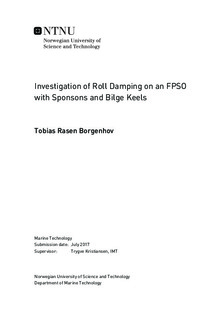| dc.description.abstract | Within Hydrodynamics, estimating the roll damping are associated with difficulties and uncertainty. This is due to roll motion being highly non-linear compared to other degrees of freedom. The non-linearity arises from flow separation. Therefore, empirical formulas have been developed \cite{ikeda1977roll} for classical ship shapes. Nonetheless, what happens when the ship hull no longer are conventional?
This theses have addressed the roll damping problem of an FPSO with sponsons by conducting experiments and numerical simulations of forced roll. A 2D mid ship section with four bilge keel length, with and without sponsons were investigated. A fixed centre of rotation was adopted based on the freely floating model's natural period in roll. The aim was to identify how the roll damping coefficient changes when sponsons are mounted on the ship side and if the damping can be restored by increasing the bilge keel height.
Experimental model tests were perform in Ladertanken, a narrow wave flume. The numerical simulations were conducted using a hybrid method package \textit{PVC-2DRoll}.
It was pointed from the results that the total roll damping was strongly dependent on the bilge keel height, both for a vessel with and without sponsons. Further, both the amplitude and period of oscillation affect how the roll damping changes by increasing bilge keel height. For the FPSO with sponsons the roll damping was dominated by the linear damping for small bilge keels, while damping for the classical ship was dominated by quadratic damping, with good similarities to previous studies.
Moreover, triple the bilge keel length of the bilge keel after mounting sponsons on the ship we obtained, in order of magnitude, the same bilge keel loads as for a conventional ship with typical bilge keel length. However, the total damping as a function of roll angle was on average 42.5\% lower than a conventional ship without sponsons. This may be due to the sponsons forming the midsection more rounded, and hence less eddy-making by the hull.
There was satisfactory and comparable results between model tests and numerical simulations for total damping on the model with and without sponsons. Bilge keel damping was extracted from bilge keel loads during the forced roll, and the agreement between experimental and numerical results was good for the model with, while model without sponsons had differences up to 61\%. The reason causing this deviation was not established.Overall it was shown both the model test method and PVC-2DRoll can be used to solve forced roll motion problems with unconventional ship shapes.
Challenges using a fixed centre of rotation where established, both physically and practically. Performing forced roll in air provided roll moments associated to bearing friction, and was subtracted from the final results. The uncertainty from repetition tests of experiments was established to be between 1\% and 5.3\%. | |

